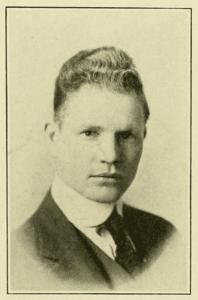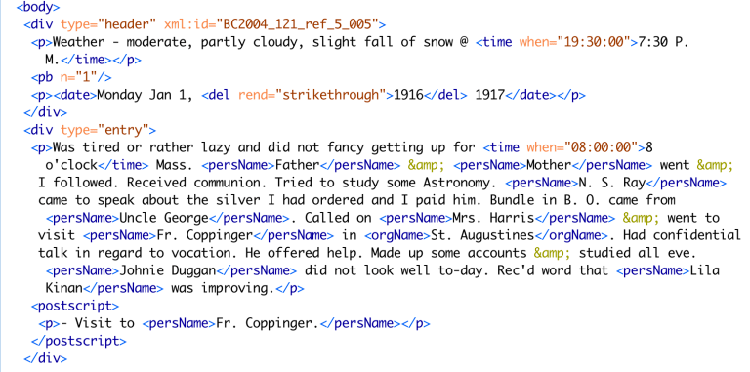Encoding the Thomas D. Craven Diary
 One hundred years after it was penned, a single diary from the Thomas D. Craven papers was digitized by Boston College Libraries. This diary was written by Thomas D. Craven during the 1917 spring semester of his senior year at Boston College when he began serving in the Army Air Corps Medical Corps during World War I. In the spring of 2018, several library and archives staff from Thomas P. O’Neill (Nancy Adams, Meg Critch, Sarah DeLorme, Anna Kijas) and John J. Burns Library (Kathleen Monahan, Annalisa Moretti) began a collaborative transcription and encoding project of the 1917 diary as a way to to make this content more widely accessible and visible, as well as to expand our expertise and understanding of the Text Encoding Initiative (TEI) through project-based learning.
One hundred years after it was penned, a single diary from the Thomas D. Craven papers was digitized by Boston College Libraries. This diary was written by Thomas D. Craven during the 1917 spring semester of his senior year at Boston College when he began serving in the Army Air Corps Medical Corps during World War I. In the spring of 2018, several library and archives staff from Thomas P. O’Neill (Nancy Adams, Meg Critch, Sarah DeLorme, Anna Kijas) and John J. Burns Library (Kathleen Monahan, Annalisa Moretti) began a collaborative transcription and encoding project of the 1917 diary as a way to to make this content more widely accessible and visible, as well as to expand our expertise and understanding of the Text Encoding Initiative (TEI) through project-based learning.
There is a long history of using TEI in archives and libraries, especially with special collections materials. For example, TEI Text Encoding in Libraries at Indiana University has maintained guidelines for best encoding practices in libraries since the 1990s. They also have several online collections that use the TEI, including The Chymistry of Isaac Newton and the Algernon Charles Swinburne project. A project focused on encoding digitized manuscripts and also serving them up as International Image Interoperability Framework (IIIF) compatible files is the Shelley-Godwin Archive project, which makes visible and accessible the digitized manuscripts, side-by-side with encoded transcriptions, and raw XML (eXtensible Markup Language). Another example is the Haverford Library and Swarthmore’s Friends Historical Library, who teamed up to encode digitized materials from their Quaker & Special Collections, in order to provide greater access and distribution of content that is often requested by researchers and scholars.

The Thomas D. Craven diary encoding project is currently under development, but you can view a sample of encoded text from this diary (created previously) and other special collections materials found in our TEI Learning Docs project hosted in the TEI Archiving, Publishing, and Access Service (TAPAS). It is part of our ongoing effort to learn the TEI, explore research and pedagogical applications of the TEI to primary source documents, and make the process and contents visible and accessible to a wider community of students, scholars, and archives/library professionals. A more detailed publicly visible write-up about our process and the development of this project can be viewed on the Digital Scholarship Blog.